F-4J Phantom Ⅱ
The real charm of this long-deployed masterpiece jet-fighter comes at you with an SWS kit. Since its first flight in 1958, the F-4 was produced in 5195 machines and extensively adopted by the countries of the former Western Bloc, achieving important results in many battlefields like Middle Eastern War, Gulf War and Vietnam War. The airframe design follows the layout of the F3H, previously built by the same manufacturer, with the sharp radome pointing to the front of the tandem cockpit. The intakes are on both sides of the cockpit, leading the air to the twin-engine J79 through the duct, enhancing the engine efficiency. A unique aircraft developed in many variations and still used by several air forces (e.g. Israeli Air Force, Japan Air Self-Defense Force) that created their own, improved versions.
- First time ever! This SWS F-4 kit in a beautiful and accurate reproduction, like never seen before.
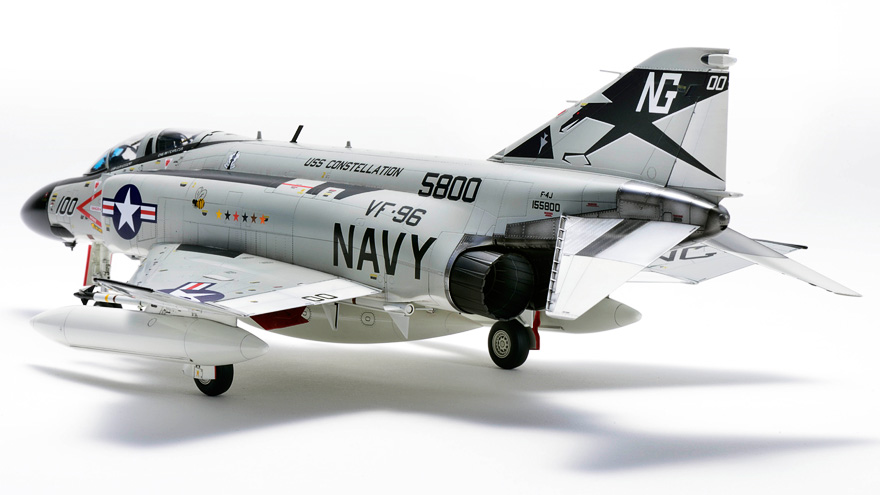 The F-4 outer shape stands out for the thick nose with its protruding sharp extremity and the air-intakes largely spread on both sides of the fuselage, while the biggest barrier during the development were the cross-sections' variations and the changes on the curved surfaces. The neck in the fuselage mid-section is stunning like the area around the intakes, and you can't overlook the curved surfaces of the rear fuselage, gradually narrowed down to the nozzle, or the complex cross-sectional variation of the rear end running out like a pen nib. This SWS kit with its elaborated appearance is probably the first in the world with such a beautiful and accurate reproduction, based on thorough researches on the real machine. Now the F-4, as you have never seen it, is yours.
The F-4 outer shape stands out for the thick nose with its protruding sharp extremity and the air-intakes largely spread on both sides of the fuselage, while the biggest barrier during the development were the cross-sections' variations and the changes on the curved surfaces. The neck in the fuselage mid-section is stunning like the area around the intakes, and you can't overlook the curved surfaces of the rear fuselage, gradually narrowed down to the nozzle, or the complex cross-sectional variation of the rear end running out like a pen nib. This SWS kit with its elaborated appearance is probably the first in the world with such a beautiful and accurate reproduction, based on thorough researches on the real machine. Now the F-4, as you have never seen it, is yours. - Thorough reproduction of the cockpits!
What are the flight controls of the F-4, which design was based on the legendary tandem seat fighter of the Navy!
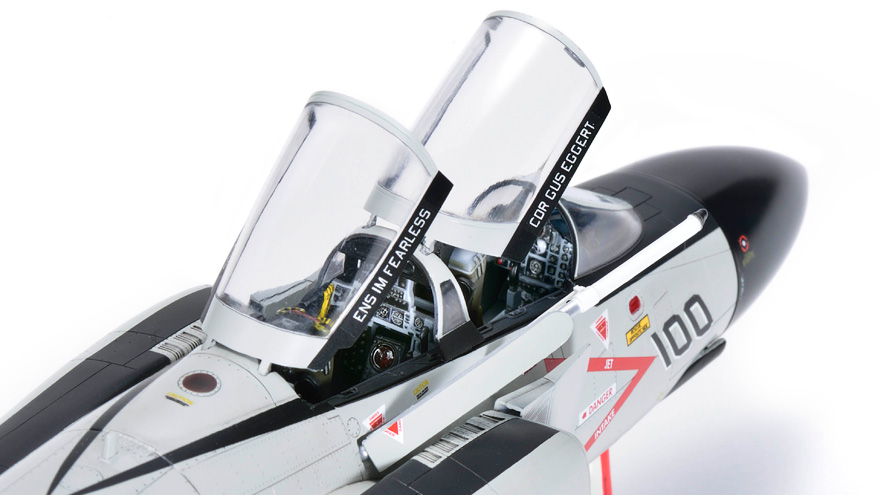 The cockpits of the F-4 are in tandem. In the US Navy type aircraft, the pilot seated on the front and the RIO (radar interceptor officer) on the back. Following the tradition of the Navy twin-seaters, all the flight controls equipment, like the control stick, are located in the front seat only. According to its name, the rear seat is equipped with monitors for the radarscope and other kind of radars, the attack system, the warning devices etc. Since every F-4 type was thought for a specific use, there were warship-fighters, interceptor-fighters, bombing-fighters etc., so the consoles of the instrument panels differed for each type. In the SWS kit, these differences have been thoroughly represented too. Please enjoy each type's particularities.
The cockpits of the F-4 are in tandem. In the US Navy type aircraft, the pilot seated on the front and the RIO (radar interceptor officer) on the back. Following the tradition of the Navy twin-seaters, all the flight controls equipment, like the control stick, are located in the front seat only. According to its name, the rear seat is equipped with monitors for the radarscope and other kind of radars, the attack system, the warning devices etc. Since every F-4 type was thought for a specific use, there were warship-fighters, interceptor-fighters, bombing-fighters etc., so the consoles of the instrument panels differed for each type. In the SWS kit, these differences have been thoroughly represented too. Please enjoy each type's particularities. - This is the real soul of SWS! Look at the intakes, the F-4 most difficult parts to recreate.
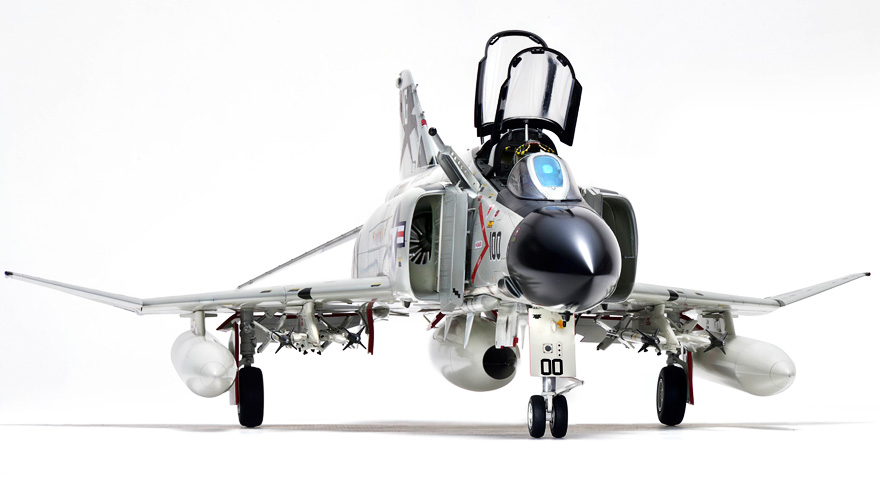 The F-4 air-intakes have a nose-enclosed shape and are positioned apart from the fuselage on both sides. A vertical intake vane is located ahead of the intakes, while the wedge-boundary between the vane and the fuselage surface has a structure loosing up and down. Also, the fossula in the center of the intakes has a structure blowing the boundary from the intake vane to the duct, and releases air to the slits located above and under the intakes. In addition, the center of the intake-lamp and the lamp beneath can be replaced, so that the appropriate air inflow could be adjusted. With the SWS kit, these complex and strange structures and shapes are perfectly reproduced without compromise, and without impacting the easiness of assembly.
The F-4 air-intakes have a nose-enclosed shape and are positioned apart from the fuselage on both sides. A vertical intake vane is located ahead of the intakes, while the wedge-boundary between the vane and the fuselage surface has a structure loosing up and down. Also, the fossula in the center of the intakes has a structure blowing the boundary from the intake vane to the duct, and releases air to the slits located above and under the intakes. In addition, the center of the intake-lamp and the lamp beneath can be replaced, so that the appropriate air inflow could be adjusted. With the SWS kit, these complex and strange structures and shapes are perfectly reproduced without compromise, and without impacting the easiness of assembly. - Unbelievable for a 1/48 scale kit! Look at these "J79" jet engines full of density.
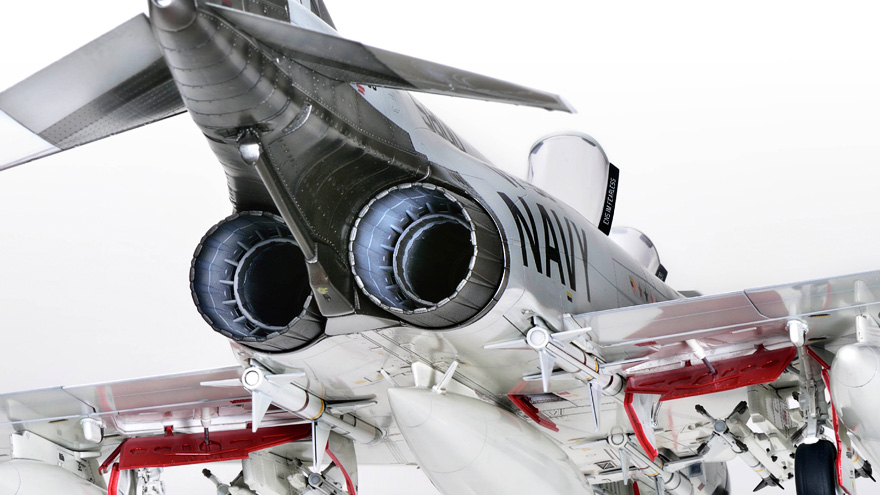 The engines equipped on the F-4 are the General Electric J79 engines, masterpiece engine of that era which was installed on the F-104 too. If we classify roughly the machines by their outer shapes, we can distinguish the short type nozzle machines like the B-type equipped with a J79-8 (7,710kg maximum thrust) or the C, D-types equipped with a J79-15 (7,710kg maximum thrust), and the long type nozzle machines like the J-type equipped with a J79-10 (8,210kg maximum thrust), and the E-type equipped with a J79-17 (8,210kg maximum thrust). The SWS kit reproduces with few parts the "J79-10" engines mounted on the J-type. Please experience the "scale-down of real machines", true charm of scale modeling.
The engines equipped on the F-4 are the General Electric J79 engines, masterpiece engine of that era which was installed on the F-104 too. If we classify roughly the machines by their outer shapes, we can distinguish the short type nozzle machines like the B-type equipped with a J79-8 (7,710kg maximum thrust) or the C, D-types equipped with a J79-15 (7,710kg maximum thrust), and the long type nozzle machines like the J-type equipped with a J79-10 (8,210kg maximum thrust), and the E-type equipped with a J79-17 (8,210kg maximum thrust). The SWS kit reproduces with few parts the "J79-10" engines mounted on the J-type. Please experience the "scale-down of real machines", true charm of scale modeling. - What about the armament and deck-landing equipment of this carrier plane used for all kinds of mission!
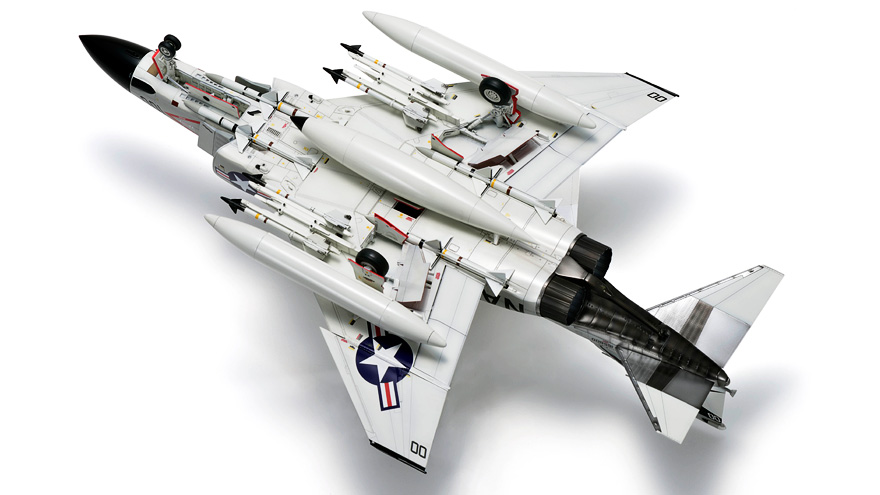 The struts of the F-4, which was developed as a carrier plane, were designed to be solid in order to resist to very hard deck landings, especially the main gears of the J-type with 76.2cm x 29.2cm high-pressure tires since the plane landed on warships. Regarding the armament, the first B, C and D-types of the F-4, which design has been based on the missile gap myth, were not equipped with fixed armaments. Their characteristic is that they could be equipped with a maximum of four AIM-7 missiles into the missile bay on the lower fuselage, and four AIM-9 missiles on the lower surface of the main wings. However, during the Vietnam War, because of the great activity of the F-8 Crusader that had 20mm machine guns, it became obvious that missiles alone were insufficient as there was nothing to do except fly away after using all of them, so that from E-type a "M61A-1" Vulcan gun fixed type was added to the nose. Since some have considered about using the plane as a bomber too, its capacity of loading a big bomb of about 7.3t is another charm of the F-4.
The struts of the F-4, which was developed as a carrier plane, were designed to be solid in order to resist to very hard deck landings, especially the main gears of the J-type with 76.2cm x 29.2cm high-pressure tires since the plane landed on warships. Regarding the armament, the first B, C and D-types of the F-4, which design has been based on the missile gap myth, were not equipped with fixed armaments. Their characteristic is that they could be equipped with a maximum of four AIM-7 missiles into the missile bay on the lower fuselage, and four AIM-9 missiles on the lower surface of the main wings. However, during the Vietnam War, because of the great activity of the F-8 Crusader that had 20mm machine guns, it became obvious that missiles alone were insufficient as there was nothing to do except fly away after using all of them, so that from E-type a "M61A-1" Vulcan gun fixed type was added to the nose. Since some have considered about using the plane as a bomber too, its capacity of loading a big bomb of about 7.3t is another charm of the F-4.
By Zoukei-Mura
























